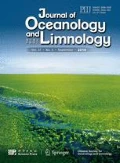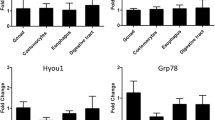Abstract
Heat shock protein 70 (Hsp70) is one important member of heat shock protein (Hsp) family that is responsible for various stresses, especially thermal stress. Here we examined the response of Hsp70 gene to both chronic and acute thermal exposure in Pacific abalone (Haliotis discus hannai Ino). For the chronic exposure, abalones were maintained at 8, 12, 20, and 30°C for four months and their mRNA levels were measured. The highest mRNA level of Hsp70 gene relative to actin gene was detected in the 30°C-acclimated group, followed by the 8°C-acclimated group and then the 12°C- and 20°C-acclimated groups. After the long-term acclimation, gills from each of the above acclimation groups were dissected and exposed to different temperatures between 8°C and 38°C for 30 min. Hsp70 expression in gills acclimated to different temperatures responded differentially to the same temperature exposure. The incubation temperature that induced maximum Hsp70 mRNA expression was higher in the higher temperature acclimation groups than lower temperature groups. Pacific abalones could alter the expression pattern of Hsp70 gene according to environmental thermal conditions, through which they deal with the stress of thermal variations.
Similar content being viewed by others
References
Boutet I, Tanguy A, Rousseau S, Auffret M, Moraga D. 2003. Molecular identification and expression of heat shock cognate 70 (HSC70) and heat shock protein 70 (HSP70) genes in the Pacific oyster Crassostrea gigas. Cell Stress Chaperones, 8(1): 76–85.
Cheng P Z, Liu X, Zhang G F, He J G. 2007. Cloning and expression analysis of a HSP70 gene from Pacific abalone (Haliotis discus hannai). Fish & Shellfish Immunology, 22(1–2): 77–87.
Farcy E, Serpentini A, Fievet B, Lebel J M. 2007. Identification of cDNAs encoding HSP70 and HSP90 in the abalone Haliotis tuberculata: Transcriptional induction in response to thermal stress in hemocyte primary culture. Comparative Biochemistry and Physiology, Part B: Biochemistry and Molecular Biology, 146(4): 540–550.
Feder M E, Krebs R A. 1998. Natural and genetic engineering of the heat-shock protein Hsp70 in Drosophila melanogaster: Consequences for thermotolerance. Am. Zool., 38(3): 503–517.
Feder M E, Hofmann G E. 1999. Heat-shock proteins, molecular chaperones, and the stress response: Evolutionary and ecological physiology. Annu. Rev. Physiol., 61: 243–282.
Franzellitti S, Fabbri E. 2005. Differential HSP70 gene expression in the Mediterranean mussel exposed to various stressors. Biochem. Bioph. Res. Co., 336(4): 1 157–1 163.
Gao Q, Song L S, Ni D J, Wu L T, Zhang H, Chang Y Q. 2007. cDNA cloning and mRNA expression of heat shock protein 90 gene in the haemocytes of Zhikong scallop Chlamys farreri. Comp. Biochem. Physiol. B: Biochem. Mol. Biol., 147(4): 704–715.
Gething M J, Sambrook J. 1992. Protein folding in the cell. Nature, 355(6355): 33–45.
Hara M, Sekino M. 2005. Genetic difference between Ezo-awabi Haliotis discus hannai and Kuro-awabi H. discus discus populations: Microsatellite-based population analysis in Japanese abalone. Fisheries Science, 71(4): 754–766.
Hartl F U. 1996. Molecular chaperones in cellular protein folding. Nature, 381(6583): 571–580.
Hartl F U, Hayer-Hartl M. 2002. Protein folding — Molecular chaperones in the cytosol: from nascent chain to folded protein. Science, 295(5561): 1 852–1 858.
Institute S. 1990. SAS/STAT User’s Guide, Version 6, 4th edition. SAS Institute, Cary, North Carolina.
Kikuchi S, Uki N. 1974. Technical study on artificial spawning of abalone, genus Haliotis I. Relation between water temperature and advancing sexual maturity of Haliotis discus hannai Ino. Bull. Tohuku Reg. Fis. Res. Lab, 33: 69–78.
Lv D H. 1978. A study on the Haliotidae from the coast of China. Studia Marina Sinic, 14: 89–100.
Mayer M P, Bukau B. 2005. Hsp70 chaperones: Cellular functions and molecular mechanism. Cellular and Molecular Life Sciences, 62(6): 670–684.
Nie Z Q, Wang S P. 2004. The status of abalone culture in China. Journal of Shellfish Research, 23(4): 941–945.
Osovitz C J, Hofmann G E. 2005. Thermal history-dependent expression of the Hsp70 gene in purple sea urchins: Biogeographic patterns and the effect of temperature acclimation. J. Exp. Mar. Biol. Ecol., 327(2): 134–143.
Rathinam A V, Chen T T, Grossfeld R M. 2000. Cloning and sequence analysis of a cDNA for an inducible 70 kDa heat shock protein (Hsp70) of the American oyster (Crassostrea virginica). DNA Sequence, 11(3–4): 261–264.
Snyder M J, Girvetz E, Mulder E P. 2001. Induction of marine mollusc stress proteins by chemical or physical stress. Arch. Environ. Contam. Toxicol., 41(1): 22–29.
Ruan W J, Lai M D. 2007. Actin, a reliable marker of internal control? Clinica Chimica Acta, 385: 1–5.
Song L S, Wu L T, Ni D J, Chang Y Q, Xu W, Xing K Z. 2006. The cDNA cloning and mRNA expression of heat shock protein 70 gene in the haemocytes of bay scallop (Argopecten irradians, Lamarck 1819) responding to bacteria challenge and naphthalin stress. Fish & Shellfish Immunology, 21(4): 335–345.
Takle H, Baeverfjord G, Lunde M, Kolstad K, Andersen O. 2005. The effect of heat and cold exposure on HSP70 expression and development of deformities during embryogenesis of Atlantic salmon (Salmo salar). Aquaculture, 249(1–4): 515–524.
Vosloo D, Vosloo A. 2010. Response of cold-acclimated, farmed South African abalone (Haliotis midae) to short-term and long-term changes in temperature. J. Therm. Biol., 35(7): 317–323.
Zhang G F, Que H Y, Liu X, Xu H S. 2004. Abalone mariculture in China. Journal of Shellfish Research, 23(4): 947–950.
Zhang Q Z, Wu X Z, Gao J S, Pan J P. 2003. Cloning, Southern blotting and RT-PCR analysis of a cDNA fragment encoding of 70 kDa heat shock protein (Hsc70) from the oyster (Crassostrea ariakensis). Acta Zool. Sin., 49(5): 708–712.
Author information
Authors and Affiliations
Corresponding author
Additional information
Supported by the National High Technology Research and Development Program of China (863 Program) (Nos. 2006AA10A407, 2012AA100812)
Rights and permissions
About this article
Cite this article
Li, J., He, Q., Sun, H. et al. Acclimation-dependent expression of heat shock protein 70 in Pacific abalone (Haliotis discus hannai Ino) and its acute response to thermal exposure. Chin. J. Ocean. Limnol. 30, 146–151 (2012). https://doi.org/10.1007/s00343-012-1026-x
Received:
Accepted:
Published:
Issue Date:
DOI: https://doi.org/10.1007/s00343-012-1026-x



